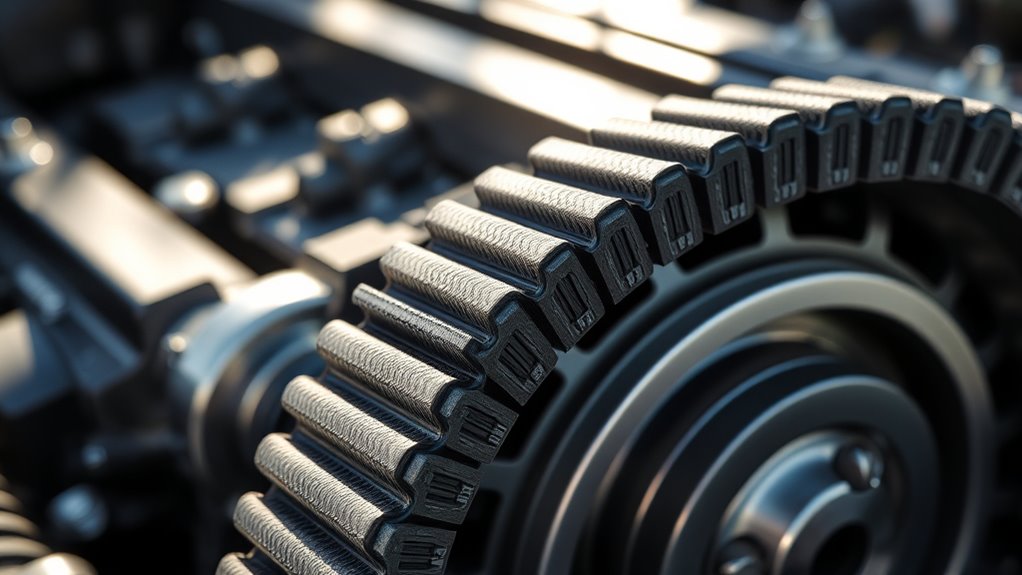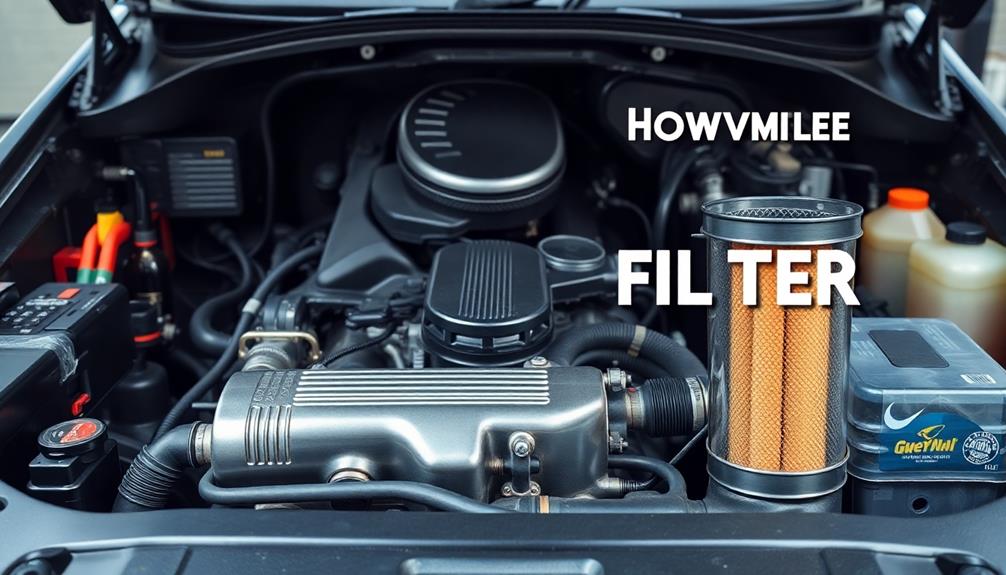Timing belt intervals generally range between 60,000 to 100,000 miles, depending on your vehicle and belt material. Rubber belts with fiberglass usually need replacement sooner, while Kevlar-reinforced belts last longer. Following your manufacturer’s recommendations is key to preventing costly engine damage. Regular inspections for cracks or fraying help, but sticking to the proper timeline is best. Keep going to discover more about how to protect your engine and save money long-term.
Key Takeaways
- Timing belt replacement intervals vary by manufacturer, typically ranging from 60,000 to 100,000 miles.
- Belt material, such as rubber or Kevlar, influences its expected lifespan and replacement schedule.
- Regular inspections for cracks or fraying help identify wear before failure occurs.
- Following manufacturer recommendations prevents engine damage and costly repairs.
- Costs for replacement include belt price, labor, and potential additional parts like water pumps.

Have you ever wondered how often you should replace your timing belt? Knowing the right timing belt interval is vital for keeping your vehicle running smoothly and avoiding costly engine damage. The first thing to think about is the belt material, which directly impacts how long your belt will last. Most timing belts are made from rubber compounds reinforced with materials like fiberglass or Kevlar. Rubber with fiberglass reinforcement tends to have a shorter lifespan, usually around 60,000 to 90,000 miles. In contrast, belts reinforced with Kevlar can last up to 100,000 miles or more because of their increased durability and resistance to wear. Checking your vehicle’s owner’s manual is essential, as manufacturers specify the recommended interval based on the belt material used in your specific model.
Understanding the belt material helps you anticipate when it’s time for a replacement. If your belt is made from high-quality materials like Kevlar or other reinforced composites, you might extend the interval slightly, but it’s still wise to follow the manufacturer’s recommendations. Conversely, if your belt is made from standard rubber, you should plan for more frequent replacements to avoid potential failure. The replacement cost varies depending on the belt material, vehicle make, and model. Generally, replacing a timing belt can cost anywhere from $500 to over $1,000. The price includes parts and labor, with the belt itself usually costing between $25 and $100. Labor costs are higher if your engine has a complex timing belt routing or if additional components like water pumps or tensioners need replacement at the same time.
The key is not just the cost but also the potential damage that can occur if you overlook timely replacement. A worn or aged belt can snap or slip, leading to severe engine damage, which could cost thousands to repair. Regular inspections during routine maintenance can help you spot signs of wear, such as cracks, fraying, or missing teeth. Even if the belt looks fine visually, it’s best to replace it within the recommended interval to avoid unexpected breakdowns. Additionally, understanding the belt material can help you make informed decisions about replacements and maintenance. Remember, the cost of replacing a belt proactively is far less than dealing with the aftermath of a belt failure. Staying informed about your car’s maintenance schedule and understanding the influence of belt material on lifespan can save you money and prevent inconvenience in the long run.
Frequently Asked Questions
How Can I Tell if My Timing Belt Is Failing Early?
You can tell if your timing belt is failing early by paying attention to wear indicators and noise symptoms. If the belt shows signs of cracking, fraying, or missing teeth, it’s a clear warning. Additionally, listen for squealing or ticking noises from the engine, which often indicate belt issues. Address these signs promptly to prevent engine damage, and consider having a mechanic inspect your belt regularly.
Are There Any Signs of Timing Belt Wear I Should Watch For?
Ever wonder what a worn timing belt looks and sounds like? You should watch for visual cues like cracks, fraying, or glossy surfaces. Noise detection is also key—listen for squealing or ticking sounds from the engine area. If your car starts misfiring or the engine runs rough, these are signs your timing belt might be failing. Regular inspections help prevent unexpected breakdowns and costly repairs.
How Does Climate Affect Timing Belt Lifespan?
Climate impact markedly affects your timing belt’s durability. In hot, dry environments, the belt may crack or wear faster due to heat and UV exposure. Conversely, cold, humid climates can cause the belt material to become brittle or develop mold. You should regularly inspect your belt, especially if you live in extreme weather, and follow manufacturer recommendations for replacement intervals to prevent unexpected failure.
Can I Extend My Timing Belt Interval Safely?
You can extend your timing belt interval, but it’s risky. Stick to your vehicle’s maintenance schedule and replace it before the recommended interval to avoid costly repairs. Ignoring the schedule may void warranty coverage if a failure occurs later. Regular inspections can help identify signs of wear, but following the manufacturer’s guidelines guarantees safety and reliability. When in doubt, replace it sooner rather than later to protect your engine.
What Are the Risks of Ignoring Timing Belt Replacement Recommendations?
Ignoring timing belt replacement recommendations is like playing with fire—you’re risking engine failure that could leave you stranded. If the belt breaks, the pistons and valves collide, causing severe internal damage. This can lead to costly repairs, often costing thousands more than a simple replacement. Don’t gamble with your engine’s health; sticking to the recommended interval saves you from unexpected breakdowns and hefty cost implications.
Conclusion
In conclusion, sticking to your timing belt intervals is like tending a garden—you’ll enjoy smooth, worry-free rides if you stay on schedule. Regular checks and replacements prevent costly engine damage, keeping your car running as reliably as a well-oiled machine. Don’t wait until it’s too late; think of your timing belt as the heart of your engine, pumping life into your vehicle. Stay proactive, and your car will thank you for it!









